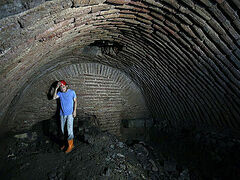Istanbul, April 16, 2025
Turkey has launched an ambitious restoration project focused on the dome of the 1,486-year-old Hagia Sophia, marking one of the most significant repair efforts in the monument’s long history, experts announced on Monday.
The comprehensive project will reinforce the main dome and half domes of the historic structure, replace worn lead coverings, and upgrade the steel framework to protect the building from potential earthquake damage in a country traversed by numerous fault lines, Reuters reports.
“It is truly a structure full of surprises because sometimes things develop in a way we do not expect. That is, you design and plan it, but when you open it, things may develop differently,” said Asnu Bilban Yalcin, a Byzantine art historian, speaking outside the Hagia Sophia.
The restoration represents “the most significant intervention in over 150 years and in the totality of the structure’s long history,” according to Dr. Mehmet Selim Okten, a construction engineer and member of the scientific council overseeing the renovations.
As part of the process, a tower crane has been installed on the eastern façade to transport materials and expedite the work. The dome will be covered with a protective frame system during the repairs, allowing experts to safely examine the building’s historical layers.
“We have been carrying out intensive restoration efforts on Hagia Sophia and its surrounding structures for three years,” Okten explained. “At the end of these three years, we have focused on the seismic safety of Hagia Sophia, the minarets, the main dome and the main arches, especially due to the expected Istanbul earthquake.”
The renewed focus on earthquake protection comes after a devastating 7.8 magnitude quake struck southern Turkey in 2023, killing more than 53,000 people. While Istanbul was spared, experts remain concerned about the city’s vulnerability due to its proximity to fault lines.
Ahmet Gulec, a cultural property conservation and repair expert, noted that the real structural issues will become more apparent once the existing lead cover is removed. The restoration will focus on weak structural points identified during earthquake simulations.
Despite the extensive nature of the work, Hagia Sophia will remain open to worshippers and visitors throughout the restoration process, though experts acknowledge this will make the repairs more challenging.
Built by Byzantine Emperor Justinian in 537, Hagia Sophia served as the world’s largest cathedral for 900 years until its capture by Ottoman Sultan Mehmet the Conqueror in 1453. It was then used as a mosque for nearly 500 years before being converted into a museum by Turkey’s secular republic in 1934. In 2020, President Tayyip Erdogan returned the structure to its status as a mosque.
“For this unique cultural heritage, we plan to use modern, lightweight materials and keep the building open to the public,” Okten said, adding that the renovation process would be “monitored transparently.”
The experts did not specify a completion date for the project, citing potential delays due to weather conditions and unforeseen additional work that may be required once restoration begins in earnest.
Visitors to the site have expressed support for the preservation efforts. “Hagia Sophia is amazing, it’s one of the world’s most important monuments,” said Cambridge University lecturer Rupert Wegerif. “It seems really important that they are going to strengthen it in case of earthquakes and preserve it.”
Follow OrthoChristian on Twitter, Vkontakte, Telegram, WhatsApp, MeWe, and Gab!




